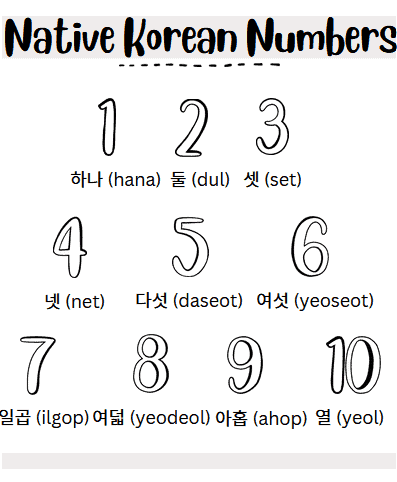Learning Korean numbers is a tad bit harder than numbers in other languages!
Besides the Korean alphabet, to become a true Korean-speaking boffin, you’d need to learn the number system as well— which has two main systems, namely Sino-Korean numbers and Native Korean numbers. The Korean language is among the hardest languages to learn , but with the right resources and effort, you will understand it in no time!
Speaking of resources, in this article, we will teach you all you need to know about the Korean numbers systems, from rules to other useful information— with this guide, you will get to know Korean numbers in no time!
Korean Numbers: Sino and Native
So, why are there two number systems? It’s hard to say. Over time, these two systems were developed or evolved. Much like most Korean girl names, these two numbering systems could be a testament to the rich history attached to Korea.
There are obvious differences between the two systems, and others are not so obvious. Here is a summary of the differences between the Sino and Native Korean number systems:
| Number System | Sino | Native |
|---|---|---|
| Origin | Koreans used Chinese characters before the creation of Hangul. As such, this numbering system is written in Chinese characters but read as one would in Hangul. | This number system is written and read in Hangul. |
| When is it used? | Used in regards to: ages, dates, phone numbers, money, temperature, measurements, seconds and minutes, and numbers over 100. | Used in regards to: People, things, ages, hours, and, numbers from 1 to 99. |
| The Zero | Zero in this system is called Yeong (영) or Gong (공). | There is no zero in this system. |
| Examples | 둘 층 아래로 (Two floors down), 저는 육십 킬로의 예요 (I’m 60 kilograms), and 사백원입니다 (Four hundred won). | 책 셋 권 샀어요 (I bought three books), 여섯 명 (Six people) and, 나는 다섯 살이다 (I am five years old). |
Sino Korean Numbers

The key to learning Sino-Korean numbers is to understand and memorize numbers 0-10, afterwards, it’s a piece of cake!
With double-digit numbers, all you have to do is combine or stack the words. For example, take 13, it’s 십삼 (sipsam) which is a combination of 10 십 (sip) and 3 삼 (sam).
27 is 이십칠 (isipchil), a combination of 20 이십 (isip) and 7 칠 (chil).
36 삼십육 (samsipyuk) which is a combination of 30 삼십 (samsip) and 6 육 (yuk) and so on.
This method can be used to count up to 99.
Here is the Hangul and pronunciation of numbers up to 99 for the Sino Number system:
| Number | Hangul (Pronunciation) |
|---|---|
| 1 | 일 (il) |
| 2 | 이 (i) |
| 3 | 삼 (sam) |
| 4 | 사 (sa) |
| 5 | 오 (o) |
| 6 | 육 (yuk) |
| 7 | 칠 (chil) |
| 8 | 팔 (pal) |
| 9 | 구 (gu) |
| 10 | 십 (sip) |
| 11 | 십일 (sibil) |
| 12 | 십이 (sibi) |
| 13 | 십삼 (sipsam) |
| 14 | 십사 (sipsa) |
| 15 | 십오 (sipo) |
| 16 | 십육 (sipyuk) |
| 17 | 십칠 (sipchil) |
| 18 | 십팔 (sippal) |
| 19 | 십구 (sipgu) |
| 20 | 이십 (isip) |
| 21 | 이십일 (isipil) |
| 22 | 이십이 (isipi) |
| 23 | 이십삼 (isipsam) |
| 24 | 이십사 (isipsa) |
| 25 | 이십오 (isipo) |
| 26 | 이십육 (isipyuk) |
| 27 | 이십칠 (isipchil) |
| 28 | 이십팔 (isippal) |
| 29 | 이십구 (isipgu) |
| 30 | 삼십 (samsip) |
| 31 | 삼십일 (samsipil) |
| 32 | 삼십이 (samsipi) |
| 33 | 삼십삼 (samsipsam) |
| 34 | 삼십사 (samsipsa) |
| 35 | 삼십오 (samsipo) |
| 36 | 삼십육 (samsipyuk) |
| 37 | 삼십칠 (samsipchil) |
| 38 | 삼십팔 (samsippal) |
| 39 | 삼십구 (samsipgu) |
| 40 | 사십 (sasip) |
| 41 | 사십일 (sasipil) |
| 42 | 사십이 (sasipi) |
| 43 | 사십삼 (sasipsam) |
| 44 | 사십사 (sasipsa) |
| 45 | 사십오 (sasipo) |
| 46 | 사십육 (sasipyuk) |
| 47 | 사십칠 (sasipchil) |
| 48 | 사십팔 (sasippal) |
| 49 | 사십구 (sasipgu) |
| 50 | 오십 (osip) |
| 51 | 오십일 (osipil) |
| 52 | 오십이 (osipi) |
| 53 | 오십삼 (osipsam) |
| 54 | 오십사 (osipsa) |
| 55 | 오십오 (osipo) |
| 56 | 오십육 (osipyuk) |
| 57 | 오십칠 (osipchil) |
| 58 | 오십팔 (osippal) |
| 59 | 오십구 (osipgu) |
| 60 | 육십 (yuksip) |
| 61 | 육십일 (yuksipil) |
| 62 | 육십이 (yuksipi) |
| 63 | 육십삼 (yuksipsam) |
| 64 | 육십사 (yuksipsa) |
| 65 | 육십오 (yuksipo) |
| 66 | 육십육 (yuksipyuk) |
| 67 | 육십칠 (yuksipchil) |
| 68 | 육십팔 (yuksippal) |
| 69 | 육십구 (yuksipgu) |
| 70 | 칠십 (chilsip) |
| 71 | 칠십일 (chilsipil) |
| 72 | 칠십이 (chilsipi) |
| 73 | 칠십삼 (chilsipsam) |
| 74 | 칠십사 (chilsipsa) |
| 75 | 칠십오 (chilsipo) |
| 76 | 칠십육 (chilsipyuk) |
| 77 | 칠십칠 (chilsipchil) |
| 78 | 칠십팔 (chilsippal) |
| 79 | 칠십구 (chilsipgu) |
| 80 | 팔십 (palsip) |
| 81 | 팔십일 (palsipil) |
| 82 | 팔십이 (palsipi) |
| 83 | 팔십삼 (palsipsam) |
| 84 | 팔십사 (palsipsa) |
| 85 | 팔십오 (palsipo) |
| 86 | 팔십육 (palsipyuk) |
| 87 | 팔십칠 (palsipchil) |
| 88 | 팔십팔 (palsippal) |
| 89 | 팔십구 (palsipgu) |
| 90 | 구십 (gusip) |
| 91 | 구십일 (gusipil) |
| 92 | 구십이 (gusipi) |
| 93 | 구십삼 (gusipsam) |
| 94 | 구십사 (gusipsa) |
| 95 | 구십오 (gusipo) |
| 96 | 구십육 (gusipyuk) |
| 97 | 구십칠 (gusipchil) |
| 98 | 구십팔 (gusippal) |
| 99 | 구십구 (gusipgu) |
So, how do you use the Sino-Korean numbering system in real-life?
-Date in Korean
Knowing how to say the date and time in Korean is important, like with any language.
Keep in mind that 년 (nyeon) means “year” and 일 (il) means day. For example, July (칠월, chil-woll) 25th, 2023 would be ****이천이십삼년 칠월 이십오일 (icheon-isibsamnyeon chil-wol isib-oil) or in Arabic notation, 2023년 7월 25일. The year always comes first, followed by the month then day, 2023/07/25.
-Money in Korean

Money is easy. It is the number followed by the word won (원), which is the currency in Korea.
For example:
- 90 won: 구십원 (gusib-won) or 90원
- 74 won: 칠십사원 (chilsibsa-won) or 90원
And so on.
-Counting Months and Days in Korean
월 (wol) means month and months is 개월 (gaewol), so counting months would look something like this:
- 1 month: 일월 (il wol) or 1월
- 5 months: 오개월 (ogaewol) or 5개월
For counting days, 낮 (naj) means day and, 날 (nal) means days.
Using the same logic as months:
- 1 day: 일 낮 (il naj) or 1낮
- 6 days: 육날 (yuk nal) or 6날
-Phone Numbers in Korean
To talk about phone numbers is easy, just read the individual numbers. For example, 232-654-2564 would be 이삼이-육오사 -이사육오 (isami-yukosa-ioyuksa).
Native Korean Numbers

Similar to the Sino numbering system, you should start off with memorizing numbers 1-10. This system does go up to 99 and beyond, but it is usually not used after the 10th number since it is primarily used to count things. The exception to this rule would be when we talk about ages, for example, 저는 쉰 세입니다 (jeoneun swin seibnida), or “I am fifty years old”.
Another similarity with the Sino system is how you would say double-digit numbers, for example, 13 열셋 (yeoset) would be a combination of 10 열 (yeol) and 3 셋 (set), you just stack the numbers.
Here is the Hangul and pronunciation of numbers up to 99 for the Native Korean number system:
| Number | Hangul (Pronounciation) |
|---|---|
| 1 | 하나 (hana) |
| 2 | 둘 (dul) |
| 3 | 셋 (set) |
| 4 | 넷 (net) |
| 5 | 다섯 (daseot) |
| 6 | 여섯 (yeoseot) |
| 7 | 일곱 (ilgop) |
| 8 | 여덟 (yeodeol) |
| 9 | 아홉 (ahop) |
| 10 | 열 (yeol) |
| 11 | 열하나 (yeolhana) |
| 12 | 열둘 (yeoldul) |
| 13 | 열셋 (yeolset) |
| 14 | 열넷 (yeolnet) |
| 15 | 열다섯 (yeoldaseot) |
| 16 | 열여섯 (yeolyeoseot) |
| 17 | 열일곱 (yeolilgob) |
| 18 | 열여덟 (yeolyeodeol) |
| 19 | 열아홉 (yeolahop) |
| 20 | 스물 (seumul) |
| 21 | 스물하나 (seumulhana) |
| 22 | 스물둘 (seumuldul) |
| 23 | 스물셋 (seumulset) |
| 24 | 스물넷 (seumulnet) |
| 25 | 스물다섯 (seumuldaseot) |
| 26 | 스물여섯 (seumulyeoseot) |
| 27 | 스물일곱 (seumulilgop) |
| 28 | 스물여덟 (seumulyeodeol) |
| 29 | 스물아홉 (seumulahop) |
| 30 | 서른 (seoreun) |
| 31 | 서른하나 (seoreunhana) |
| 32 | 서른둘 (seoreundul) |
| 33 | 서른셋 (seoreunset) |
| 34 | 서른넷 (seoreunnet) |
| 35 | 서른다섯 (seoreundaseot) |
| 36 | 서른여섯 (seoreunyeoseot) |
| 37 | 서른일곱 (seoreunilgop) |
| 38 | 서른여덟 (seureunyeodeol) |
| 39 | 서른아홉 (seureunahop) |
| 40 | 마흔 (maheun) |
| 41 | 마흔하나 (maheunhana) |
| 42 | 마흔둘 (maheundul) |
| 43 | 마흔셋 (maheunset) |
| 44 | 마흔넷 (maheunnet) |
| 45 | 마흔다섯 (maheundaseot) |
| 46 | 마흔여섯 (maheunyeoseot) |
| 47 | 마흔일곱 (maheunilgop) |
| 48 | 마흔여덟 (maheunyeodeol) |
| 49 | 마흔아홉 (maheunahop) |
| 50 | 쉰 (swin) |
| 51 | 쉰하나 (swinhana) |
| 52 | 쉰둘 (swindul) |
| 53 | 쉰셋 (swinset) |
| 54 | 쉰넷 (swinnet) |
| 55 | 쉰다섯 (swindaseot) |
| 56 | 쉰여섯 (swinyeoseot) |
| 57 | 쉰일곱 (swinilgop) |
| 58 | 쉰여덟 (swinyeodeol) |
| 59 | 쉰아홉 (swinahop) |
| 60 | 예순 (yesun) |
| 61 | 예순하나 (yesunhana) |
| 62 | 예순둘 (yesundul) |
| 63 | 예순셋 (yesunset) |
| 64 | 예순넷 (yesunnet) |
| 65 | 예순다섯 (yesundaseot) |
| 66 | 예순여섯 (yesunyeoseot) |
| 67 | 예순일곱 (yesunilgop) |
| 68 | 예순여덟 (yesunyeodeol) |
| 69 | 예순아홉 (yesunahop) |
| 70 | 일흔 (ilheun) |
| 71 | 일흔하나 (ilheunhana) |
| 72 | 일흔둘 (ilheundul) |
| 73 | 일흔셋 (ilheunset) |
| 74 | 일흔넷 (ilheunnet) |
| 75 | 일흔다섯 (ilheundaseot) |
| 76 | 일흔여섯 (ilheunyeoseot) |
| 77 | 일흔일곱 (ilheunilgop) |
| 78 | 일흔여덟 (ilheunyeodeol) |
| 79 | 일흔아홉 (ilheunahop) |
| 80 | 여든 (yeodeun) |
| 81 | 여든하나 (yeodeunhana) |
| 82 | 여든둘 (yeodeundul) |
| 83 | 여든셋 (yeodeunset) |
| 84 | 여든넷 (yeodeunnet) |
| 85 | 여든다섯 (yeodeundaseot) |
| 86 | 여든여섯 (yeodeunyeoseot) |
| 87 | 여든일곱 (yeodeunilgop) |
| 88 | 여든여덟 (yeodeunyeodeol) |
| 89 | 여든아홉 (yeodeunahop) |
| 90 | 아흔 (aheun) |
| 91 | 아흔하나 (aheunhana) |
| 92 | 아흔둘 (aheundul) |
| 93 | 아흔셋 (aheunset) |
| 94 | 아흔넷 (aheunnet) |
| 95 | 아흔다섯 (aheundaseot) |
| 96 | 아흔여섯 (aheunyeoseot) |
| 97 | 아흔일곱 (aheunilgop) |
| 98 | 아흔여덟 (aheunyeodeol) |
| 99 | 아흔아홉 (aheunahop) |
And how would we use this numbering system in real life?
-Counters in Korean
The primary function of this numbering system is to count anything that is countable, to name a few:
- Four tables: 테이블 넷 개 (teibeul net gae)
- Two books: 둘 권 (dul gwon)
- Six people: 여섯 명 (yeoseot myeong)
and so forth.
-Age in Korean
As mentioned before, you use the Native Korean numbering system to talk about age, which is fairly simple:
- 30 years old: 서른 살 (seoleun sal)
- 22 years old: 스물 두 살 (seumul du sal)
How to Count Korean Numbers: Large Numbers

Remember, for numbers larger than 10, we use the Sino-Korean numbering system. All numbers work in this “stacking” manner: The leading number + The “inside” numbers.
The word for hundred in Korean is 백 (baek), which will come in handy when counting in Korean hundreds. Big numbers are similar to small numbers. For example, 150 백오십 (baekosip) is a combination of the leading number 100 백 (baek) and inside number 50 오십 (osip).
The word for two hundred in Korean is 이백 (ibaek), and works the same way; 260 이백육십 (ibaek yuksip) is a combination of 200 이백 (ibaek) and 60 육십 (yuksip).
Check out this chart to get a better picture!
| Number | Hangul (Pronunciation) |
|---|---|
| 100 | 백 (baek) |
| 150 | 백오십 (baekosip) |
| 500 | 오벡 (obaek) |
| 1000 | 천 (cheon) |
| 1500 | 천 오벡 (cheon obaek) |
| 5000 | 오천 (ocheon) |
| 10,000 | 만 (man) |
| 15,000 | 만오천 (man ocheon) |
How to Count Korean Numbers: the Zero
A little trick to count Korean numbers is by counting the zeros!
Take 10 000 000 for example, in increments of 10 000, with four zeros. We know that 10 000 means 만 (man). Eliminating the four zeros from the right side of the number would give you 10 000 000, which is 천 (cheon). So in conclusion, 10 000 000 in Korean is 천만 (cheonman.)
Let’s take 20 000 000. We know that 20 000 means 이만 (iman). Eliminating the four zeros from the right side of the number gives 20 000 000, two thousand in Korean is 우리 (uli). So that means 20 000 000 is 우리이만 (uliiman).
The rule applies to both rounded and non-rounded numbers. With non-rounded numbers, using the method, you remove four digits from the right then start with the number left over on the left-hand side.
The rule also applies to bigger numbers, but the amount of zeros you eliminate depends, for example, 100 000 000, or one hundred million, you eliminate 8 zeros.
Summary of Korean Numbers
Here is a summary of important things you should know in terms of Korean Numbers:
- The Sino Numbering system is used in regard to ages, dates, phone numbers, money, temperature, measurements, seconds and minutes, and numbers over 100.
- The Native Korean Numbering system is used in regard to People, things, ages, hours, and, numbers from 1 to 99.
- Sino has a word for zero which is Yeong (영) or Gong (공), whereas Native does not.
FAQs
Similar to most historic mysteries, no one really knows. Over time, these two systems were developed or evolved alongside the rich history of Korea.
Only the Sino-Korean numbering system has a word for zero, Yeong (영) or Gong (공).
Learning How to Count in Korean is Just the First Step

Besides learning simple, albeit, important phrases such as happy birthday in Korean— From Japanese numbers to Chinese numbers, numbers are just as important in every language!
Unfortunately, some numbering systems are harder than others. Which could leave you a bit dumbstruck about how you would even begin to study it. Luckily for you, we have a variety of professional online language tutors to help guide you even through the toughest of numbering systems! Best of all, you get to learn from the comfort of your home, whenever you want!
All of this, and so much more, at AmazingTalker.
















